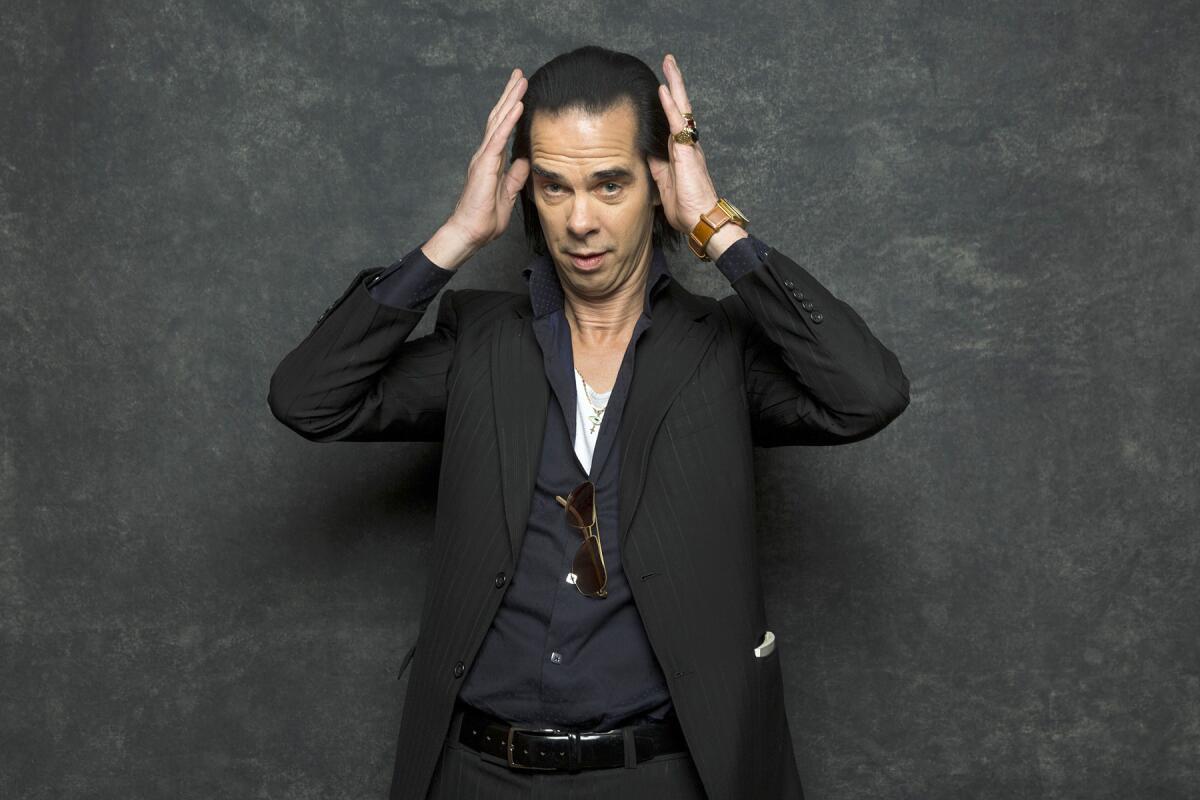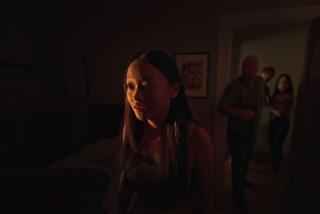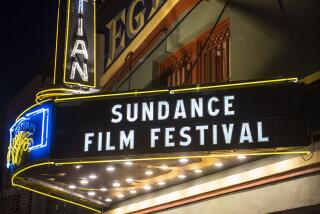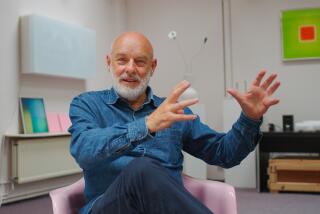The real Nick Cave? In ‘20,000 Days on Earth,’ take your pick

For a film that received two documentary prizes at the Sundance Film Festival, “20,000 Days on Earth” is very honest about how fake it is. Or rather, the film acknowledges that through a series of constructed scenarios and encounters it is able to reveal deeper truths about its subject, the musician and writer Nick Cave.
The core of the film, which opens Friday in Los Angeles, is a series of unscripted conversations held in highly constructed environments. Cave sits for a session with a psychoanalyst. He drives around in a sleek luxury car and picks up for individual talks the actor Ray Winstone, singer Kylie Minogue and former collaborator Blixa Bargeld. There is time spent in an archive of Cave memorabilia and ephemera.
There are also some spectacular musical performances, capturing Cave and his group, the Bad Seeds, at the quicksilver moment of creation in the studio while recording their recent album “Push the Sky Away” and in raging full bloom onstage.
In pulling back the curtain to reveal another curtain, directors Jane Pollard and Iain Forsyth have created something that is more truthful for acknowledging its artifice. The film becomes a rather dazzling exploration of self-creation, mythology and the architecture of a persona. The duo, with a background in the fine art world and having collaborated in the past with Cave on music videos and other projects, is making its feature film debut.
“We couldn’t have made it with anybody else; we don’t have that friendship and that trust,” said Pollard during a recent phone call from the home she shares with Forsyth in East London. “On paper, the idea was a bit preposterous. You can imagine Nick’s face, like ‘I’m doing what?’ But I think because we had this long collaboration, he was willing to go, ‘Well, all right. But if it doesn’t work, we don’t use it.’”
Forsyth added, “If you look at a lot of music documentaries, particularly in recent years, there is the tendency to want to reveal the man behind the rock star, the person behind the myth, to peel away the layers of mask and artifice. And just having spent so much time with Nick, it just seemed sort of a preposterous proposition to us, to try to take away that stuff because it felt to us like all of that mythology and all of that creation was a part of who Nick really is.”
Rather, they looked to the mix of music and myth-making in such works as the Led Zeppelin concert film “The Song Remains the Same” or the Rolling Stones’ collaboration with Jean-Luc Godard on “Sympathy for the Devil.”
There is also something about Cave the artist that makes him a particularly responsive subject to an unusual project of this type. Over the course of a career that dates back to the 1970s, the Australian-born musician, 57, has assumed many guises, including junkie outlaw and romantic balladeer. He has also published numerous books and written the screenplays for the films “The Proposition” and “Lawless.”
Over the summer at an event for “20,000 Days” in Los Angeles, Cave sat at a piano to take questions and requests from a movie theater full of people. More than once, Cave — whose signature song may be “The Mercy Seat,” written from the point of view of a man on his way to the electric chair — was told by couples that his music was played at their wedding. The wild man and the lover man, rolled into one.
In an interview the next morning, Cave agreed that the film reflects many of his own current preoccupations, but that it also brings up questions he at times finds himself unable to fully answer.
“I’ve never been asked more, now that the movie’s been made, ‘What is the real Nick Cave?’” he said. “And the idea that there’s a real one and there’s a not-real one, I don’t buy that in the first place. At some point you just become whatever idea you had. If you’re successful in some way at presenting that idea, that mask, if you want to say, eventually that mask calcifies onto the face and it just becomes you.”
Pollard and Forsyth first met at Goldsmiths College in London. Their best known works are a series of exactingly restaged events, such as David Bowie’s 1973 farewell Ziggy Stardust concert and a notorious 1978 show played by the Cramps at the Napa State Mental Hospital.
Filming began with Cave and his musical collaborator Warren Ellis at work in Brighton, England, where Cave has lived in recent years, before moving on to a recording studio with the full band in France. It was there that Forsyth and Pollard captured a riveting early take of the epic story-song “Higgs Boson Blues,” as the band is figuring out the music, Cave is editing his lyrics as he sings them and it is all coming together in real time.
It was seeing that footage, and realizing how rare of a moment it was to capture on film, that convinced Cave the larger project was worthwhile. “It showed that weird intensity where things are unknown and a discovery at the same time,” he said. “You can see everyone feels like we’re onto something but we don’t really know what it is.”
“I feel as proud of being able to know what to do and what not to do to allow that to get onto tape as I do about creating that constructed side of the film,” said Pollard of that footage. “I think there is also an art to being able to get chemistry and electricity on film.”
With “20,000 Days on Earth,” the filmmakers have created a portrait of a single artist, but also something that penetrates the myth of the rock star, the fan’s imagination and the process of creativity.
One of the last scenes shot for the film was of Cave sharing a lunch prepared by Ellis. The two talk of performances they saw of Jerry Lee Lewis and Nina Simone and they seem themselves awe-struck by these musical elders, just as others might be of them.
“We were trying to make a film about Nick that didn’t only exist for the niche of hard-core Nick Cave fans,” said Forsyth. “And I think for us that story and that moment really kind of illustrated that there are things we all feel. We all have these moments of transcendence, artists that have meant something to us, records or performances that have changed something about us and the way we think about or see the world.
“I think it’s really what we are all reaching for — whether it’s Nick Cave we’re a fan of, or Britney Spears.”
More to Read
Only good movies
Get the Indie Focus newsletter, Mark Olsen's weekly guide to the world of cinema.
You may occasionally receive promotional content from the Los Angeles Times.







